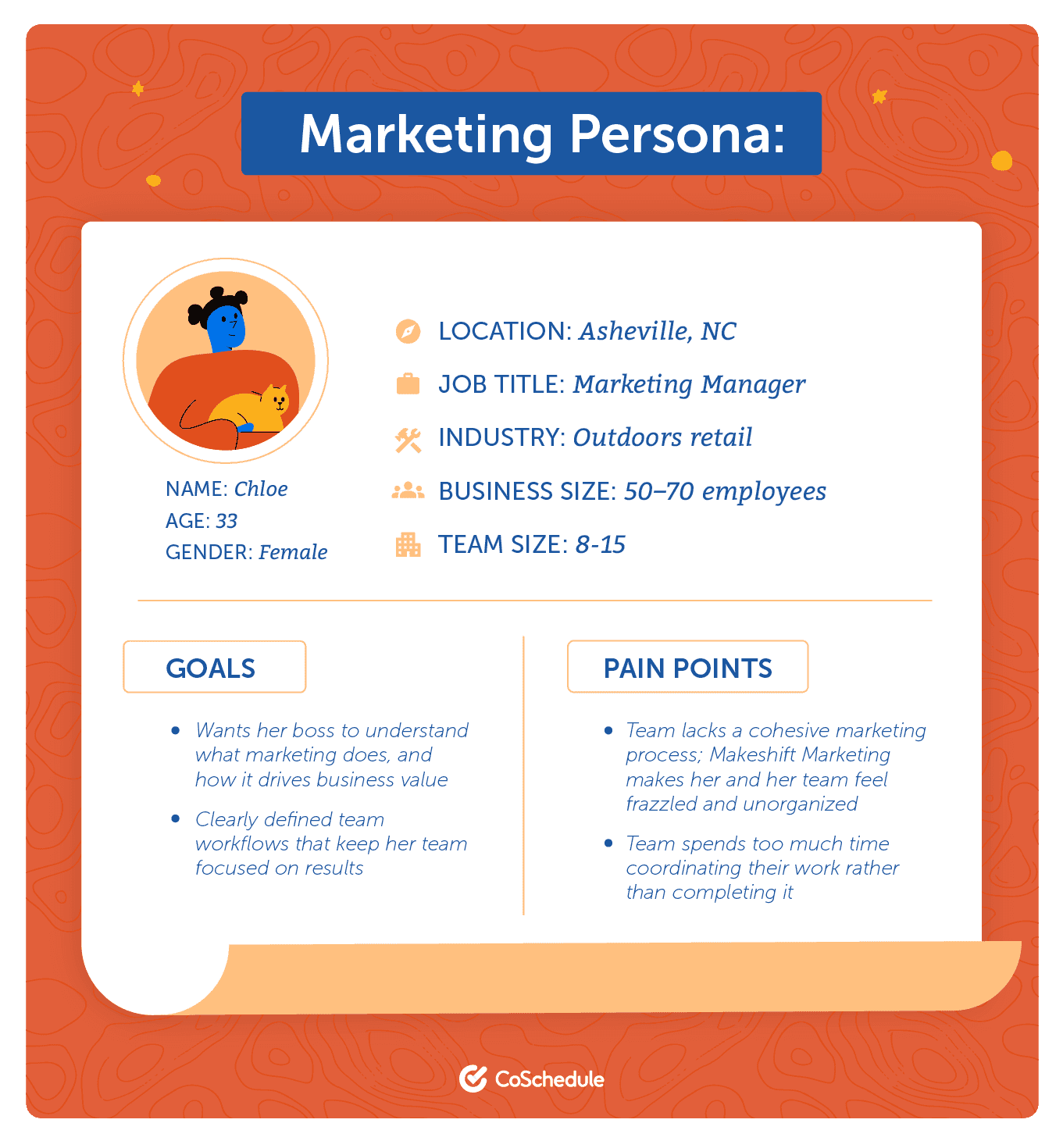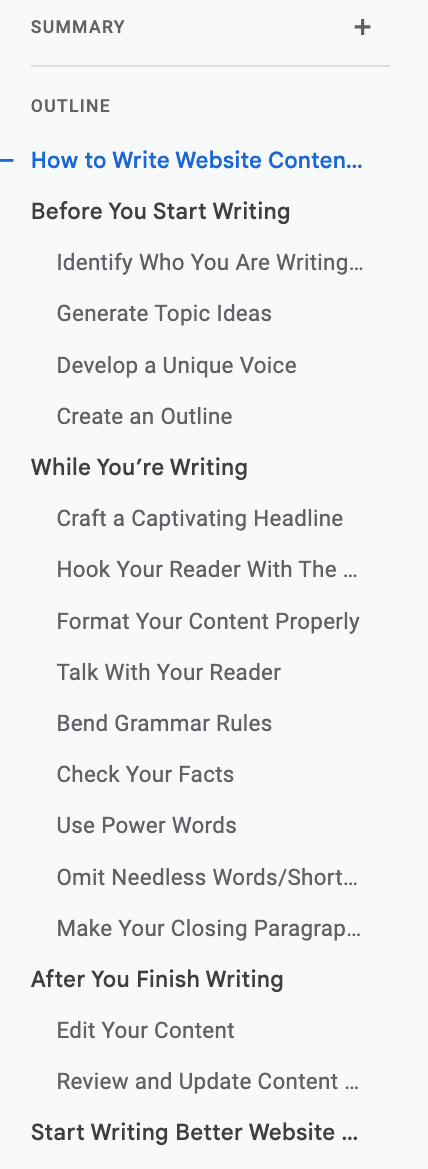As a marketer, it’s crucial not only to know how to write — but, more importantly, to know how to write website content that people want to read. After all, part of your job is to write website content that attracts visitors to your website, educates them, and converts them into Marketing Qualified Leads (MQLs).
However, despite the importance of written website content, the internet is filled with painstakingly dull content. It’s almost as if most blog posts were written for only robots and search engines.
If you’re wondering how to write website content that draws an audience in, leaves them wanting more, and eventually wins them over to becoming customers, you’ve come to the right place.
This blog post will show you some of the best practices, like using everyday lingo and making your content scannable, that’ll help you attract, engage, educate, and convert your readers.
For the sake of simplicity, I’ve placed these best practices into three different categories — what to do:
- Before you start writing
- While you’re writing
- After you finish writing
Let’s dig in.
[table of contents]
Before You Start Writing
Writing great content starts before you put pen to paper (or fingers to the keyboard). It’s similar to how you need to have a location in mind before deciding to embark on a road trip.
Before you start writing, here are some things to do that make your website content work better for you.
Identify Who You’re Writing For
Show me an amateur marketer, and I’ll show you a person trying to target everyone with their content.
Website content that tries to talk to everyone eventually ends up going in different directions and speaking to no one. To make your content work, you need to lay a strong foundation – that is, know who you’re writing for.
While you want as many people as possible to read your writing, you should focus on writing for a single ideal reader only. You want to ensure your content resonates with this reader, speaks to their pains and challenges, and offers the help they need.
With a specific reader in mind, your writing becomes more personal and feels like you’re having a conversation with them standing right in front of you.
So how do you identify who you’re writing for? The easiest way to do this is by creating a buyer persona if you don’t already have one.

A buyer persona helps you identify the basic characteristics of your ideal reader, like their age, location, gender, interests, and income level.
On a deeper level, a buyer persona helps you identify what motivates your ideal reader, what keeps them up at night, their habits, fears, aspirations, goals, etc.
A clear picture of who you’re writing for will help you present your content in a way they’ll most likely enjoy. That way, you’ll have taken the first step in building a trusting relationship with your audience.
Generate Topic Ideas
Once you know who you’re writing for, it’s time to think about content topic ideas.
Your topic ideas should revolve around what your ideal reader would want to read about. For example, I wouldn’t want to read about your chicken farm as a vegan.
You can find or generate topic ideas in different ways. You can start the old-fashioned way — by having a brain dump and writing down just about any topic idea that comes to your mind.
As you write these ideas down, consider your ideal reader and what topics would serve them. Do you want to help them:
- Overcome a struggle?
- Learn more about your products and services?
- Help them make a buying decision?
- Avoid a mistake?
Or is it something else entirely?
Here are some other ways you can find topics that interest your ideal reader:
- Use SEO tools like Ahrefs and Ubersuggest to find questions and terms your audience is searching for online.
- Check what your competitors are writing about.
- Talk directly to your audience through customer surveys or one-on-one interviews to learn what they need help with and the type of content they prefer.
Develop A Unique Voice
Your voice plays a significant role in the impression your content leaves on its readers.
It’s crucial to have a unique voice because a typical reader has a ton of other websites to choose from. If you sound like everyone else, you’ll easily get lost in the crowd, and it will be hard for your target reader to find you.
With over 4.4 million blog posts published daily, it’s like finding a needle in a haystack the size of Yankee Stadium.
Developing a unique voice again has to do with your ideal reader. How would you speak with them? Casually? With humor? Authoritatively? Or passionately?
After you know who you’re writing for, what you want to write about, and the voice to use while writing, you can move on to creating an outline — the final pre-writing best practice.
Create An Outline
Just as a layout helps builders construct buildings, so too do outlines help you write excellent content.
Before writing, you should create an outline to give your content a bit of structure. A content outline helps reduce the fear of staring at a blinking cursor on a blank page. In addition, content outlines help your writing have an easy-to-follow flow.
Your outline doesn’t need to be super fancy or elaborate. Here’s a simple 5-step process to create an outline that works.
Five-Step Process for Creating an Efficient Outline
- Choose a working title
- Determine what you want readers to take away from your content
- Organize these takeaways into related categories and by the order they should logically appear
- Fill in the gaps
- Review and add any other missing details
If you’re using writing software like Google Docs, you’ll notice the outline form automatically as you fill in your H2s, H3s, and so on.
For instance, here’s what the outline for this post looks like:

Here’s a free outline template that can help you get your creative juices flowing.
While You’re Writing
It’s time to roll up your sleeves, get your hands dirty, and start writing.
To build on the excellent groundwork you’ve laid in the pre-writing stage, here are some best practices to follow to make your content resonate with your audience.
Craft A Captivating Headline
With a million and one things fighting for people’s attention today, your header needs to grab your reader’s attention immediately.
An excellent headline draws a reader in and makes them curious.
Before you write your headline, think about how it relates to your reader and how it promises a solution to an issue plaguing them.
You can get past generic headlines and be specific by zeroing in on your content’s benefits.
For instance, a generic headline like “How to lose weight” could become “How to lose stubborn belly fat in 90 days,” — which instantly sounds more interesting.
Another thing that can help you craft great headlines is to turn to headline templates that have stood the test of time. Some examples of these templates are:
Examples of Timeless Headline Templates
- How to [desired result]
- X mistakes that [what it can cost your reader]
- The secret to [something your reader wants to achieve]
- What [famous person/company] can teach you about [something your reader wants to learn]
- X proven ways to [achieve results] in [timeframe]
To ensure you don’t run out of headline ideas, we recommend keeping a swipe file containing headlines that have caught your attention. You shouldn’t copy these headlines when writing yours, but they can surely serve as inspiration.
It also helps to write multiple headlines instead of relying on just one. You never know — your best headline might be the 10th one you write.
After writing your headline, you can use CoSchedule’s Headline Analyzer to test its quality.
Hook Your Reader With The First Sentence
Your headline has brought your reader to the door. How do you get them to step in, take off their coats, and have a warm cup of coffee?
It’s by hooking them with your introduction and the rest of your sentences and paragraphs.
Your first sentence needs to be irresistible and make your reader want to read the following sentence and the sentence after that until they reach the end.
Remember that your readers have many things already fighting for their attention. So if they sense that what they’re about to read is boring or valueless, it won’t be long before they jump ship and do something else.
Here are some tips to help you write interesting intros.
Tips for Writing Interesting Intros
- Don’t bury the lede. There’s no point wasting your readers’ time by having them read 300+ words of fluff before they know whether they’re in the right place. So, get right into the meat of your article from your intro.
- Ask a question. Questions work well to keep your reader engaged and curious. They’ll want to find answers to your questions and, as such, continue reading your piece.
- Use simple copywriting formulas. One of my favorites is the PAS (Problem-Agitate-Solution) framework. Using this framework involves mentioning your reader’s problems, agitating the problem (or highlighting what that problem is costing your reader), and then offering a solution.
- Open with an interesting statistic or data point — but use it in the right context.
Remember that the goal of the first sentence is to get the second one read.
Format Your Content Properly
Most people don’t enjoy reading large chunks of text. Some even find it somewhat intimidating.
Your content is supposed to welcome readers and not scare them away.
So as you write, be generous with the use of white space.
Write short sentences. They are easier on the eyes and quicker to move on from. The paragraphs you form from these sentences should be short too. Try to keep them within 3-4 sentences.
Furthermore, using different formatting styles can make your copy easier to read. Use bold and italic text to emphasize phrases and words. Bullet points and numbered lists work well for itemizing. Don’t forget your subheading too.
Proper formatting also includes using relevant images to break up texts, add context, and evoke emotions in your readers.
All of these work together to engage your readers and keep them glued to your content.
Talk With Your Reader
Your content should read like a conversation where you’re talking with your reader, not at them.
One of the simplest ways to make your reader feel you’re talking with them is by using “you” in your content.
This simple word shifts your content’s focus away from yourself, your company, or your product and places it on your reader. That way, your reader will feel you’re speaking directly to their problems and pains.
Since you started reading, you might have noticed how we’ve made this article all about you. Do the same for your readers too.
Another way you can make your content feel like a conversation is by using an active voice. So instead of “The car was pushed by the boy,” write “The boy pushed the car.”
Bend Grammar Rules
Rules are meant to be broken or bent. Maybe not all rules, but at least the grammar rules you learned in Mrs. Park’s English class.
You know? The rules about never starting a sentence with ‘and’ and ‘but’ or not ending a sentence with a preposition.
The truth is, many readers wouldn’t mind. And they’d rather have you bend these rules than read through an article that reads like a term paper or Ph.D. thesis.
However, when it comes to bending grammar rules, it’s crucial to keep your ideal reader in mind. Will it bother them? Are they in an industry that emphasizes “correct” English? If so, try to gear your grammar toward their industry norm.
Check Your Facts
Have you ever received an email where your name was misspelled?
Instead of ‘Hi Anne,’ you got a ‘Hi Ann.’ You’d instantly lose the motivation to read the rest of the email if you’re like most people.
Readers have the same reaction when they notice simple details — like names, dates, and numbers — are inconsistent across your content.
So instead of rushing to publish your content, take your time to check that all your facts are accurate.
Use Power Words
To illustrate the importance of power words, let’s compare these two sentences.
A: 5 ways to build self-discipline
B: 5 proven ways to build unshakeable self-discipline
Which of these sentences packs a stronger punch? Definitely the second one.
Power words work because they evoke different emotions — fear, delight, amusement — in your reader and make them feel more connected to what they’re reading. On the other hand, weak words conjure up little or no emotions in readers.
As you write, switch out boring words for more powerful ones. One effective way to catch weak words in your writing is by looking for words you pair with ‘very.’ Instead of using ‘very,’ replace them with stronger adjectives.
For instance,
- Very bad becomes awful/poor.
- Very happy becomes elated/thrilled.
- Very small becomes minute/tiny.
This graphic shows 201 emotional or power words you can use in your content.
201 Emotional/Power Words
- Free
- Professional
- Tested
- Limited
- Big
- Valuable
- Unlimited
- Underpriced
- Launching
- Better
- Spotlight
- Largest
- Unlock
- Announcing
- Introducing
- Wanted
- Interesting
- Highest
- The truth about
- Affordable
- Attractive
- Competitive
- Innovative
- Surefire
- Crammed
- Astonishing
- High-tech
- Urgent
- Portfolio
- Excellent
- Surging
- Bargain
- Pioneering
- Genuine
- Complete
- Quality
- Lavishly
- Breakthrough
- Sampler
- Unconditional
- Security
- Revolutionary
- Proven
- Surprise
- Sizable
- Secrets
- Famous
- Outstanding
- Liberal
- Superior
- Compromise
- Zinger
- Helpful
- Selected
- Successful
- Monumental
- Easy
- Strange
- Download
- Intense
- Genius
- Comprehensive
- Dreamy
- Unbelievable
- Wild
- Master
- Quick-start
- Sale
- Guaranteed
- Improved
- Simplistic
- Popular
- How to
- Discount
- Suddenly
- Skill
- Shrewd
- Useful
- Colossal
- Fortune
- Huge
- Practical
- Absolutely
- Challenge
- Expert
- Compare
- Ultimate
- Easily
- Full
- It’s here
- Soar
- Growth
- Imagination
- Latest
- Amazing
- Revealing
- Remarkable
- Revisited
- Hurry
- Destiny
- Informative
- Last chance
- Gigantic
- Reliable
- Emerging
- Noted
- Timely
- Refundable
- Miracle
- Reward
- Delighted
- Wonderful
- Scarce
- Strong
- Energy
- Rare
- Unparalleled
- Odd
- Simplified
- Special
- Sturdy
- Opportunities
- Startling
- Direct
- Value
- Profound
- Gripping
- Life-changing
- Charming
- Mesmerizing
- Unseen
- Instantly
- Bonus
- Intriguing
- New
- Special
- Immediately
- Powerful
- Exclusive
- Endorsed
- Fundamentals
- Perspective
- Reduced
- Enormous
- Survival
- Now
- Authentic
- Gift
- Focus
- Lowest
- Lifetime
- Advice
- Colorful
- Willpower
- Approved
- Mammoth
- Just arrived
- Beautiful
- Promising
- Greatest
- Important
- Exciting
- Sensational
- Obsession
- Unique
- Daring
- Unsurpassed
- Mainstream
- Exploit
- Love
- Terrific
- Profitable
- Luxury
- Bonanza
- Quickly
- Magic
- Weird
- Confidential
- Delivered
- Alert
- Unusual
- Instructive
- Edge
- Fascinating
- Bottom line
- Tremendous
- Technology
- Wealth
- Last-minute
- Quick
- Simple
- Insider
- Guilt-free
- Captivating
- Unbreakable
- Delicious
- Unleashed
- Polarizing
- Increase
- Essential
- Transform
These words help you engage your reader on a deeper level.
Omit Needless Words/Shorten Long Phrases
You need to fight the tendency to show off your writing skills or vocabulary while writing — especially when it’s not serving the reader.
Don’t use a long word or phrase when a short one would fit perfectly in its place. This means noting how often you use adverbs and adjectives in your sentences. Sure, those descriptive words have their place, but sometimes it’s better to use more precise words.
Lengthy phrases are like speed bumps that slow down your readers and make it difficult for them to follow your content. You can remove these bumps by shortening any long phrases in your writing.
Here are some examples of long phrases and their concise alternatives. Replace:
Long Phrases & Concise Alternatives
- Along the line of with Like
- At the present time with Now
- Due to the fact that with Because
- On the occasion of with When
- For the purpose of with For
- In order to with To
Make Your Closing Paragraph Memorable
As readers reach the end of your article, they should meet a paragraph that motivates them to act.
Your concluding paragraph doesn’t have to summarize all you’ve been saying. Neither should it be an afterthought.
So how do you write excellent conclusions? Here are some tips you can use.
Tips to Writing Excellent Conclusions
- Establish a connection between your opening and closing statements. Perhaps, you started the article with a story or analogy. You could link back to the story in your conclusion.
- Ask the “So what?” question. This question helps you identify why readers should care about your writing. As you ask this question and refine your writing’s relevance to your reader, you’d find better ideas for your conclusion.
- Encourage your reader to take action. After reading your content, let your readers know what you want them to do. Is it to download an ebook? Buy a product? Sign up for your email list? Share the content with their network? Whatever it is, make it clear in your conclusion.
After You Finish Writing
Phew. You’ve finally gotten around to completing your first draft. But it’s not quite ready yet for people to read. You still need to spend some time polishing what you’ve written and making it as good as it can be.
Here’s what to do to improve your first draft.
Edit Your Content
Editing helps you weed out any unnecessary words, phrases, sentences, or paragraphs that don’t serve your content’s purpose.
For instance, if your content is about how to write better content, you should remove everything that doesn’t tell your reader how to write better content.
Editing also involves checking your punctuation, looking for spelling errors, and proofreading.
Spelling errors can easily creep into your content with your notice. So take your time to go over the piece multiple times. Or you could use a tool like Grammarly to check.
It’s best practice to allow your content to sit for a while, say a day or two, before getting back into it with fresh editing eyes. That way, you’d be able to catch more errors. It also helps to have an editing or proofreading partner to check your work once you complete the first draft.
Review & Update Content Over Time
As time passes, you can expect that your content becomes outdated as new stats, data, developments, and technology within your industry come to light.
As such, it’s crucial to take the time, even after publishing, to review and update your content.
That way, your content remains fresh, continues to perform over time, and your readers will continue to find it valuable.
Start Writing Better Website Content
Writing content people want to read is not easy — but it’s well worth the effort.
The 15 tips we’ve shared can help you strengthen your writing muscles and set you well on your way to creating better website content.
With enough practice, you can consistently produce high-quality content over time. And as you write these quality pieces, readers will trust you more and view you as an authority in your industry.



![Read more about the article How CoSchedule Markets Multiple Product Lines (and How You Can Make Major Pivots With Confidence) With Nathan Ellering From CoSchedule [AMP 228]](https://www.dimaservices.agency/wp-content/uploads/2021/03/228_Nathan-Podcast-Graphics_header-300x128.png)
